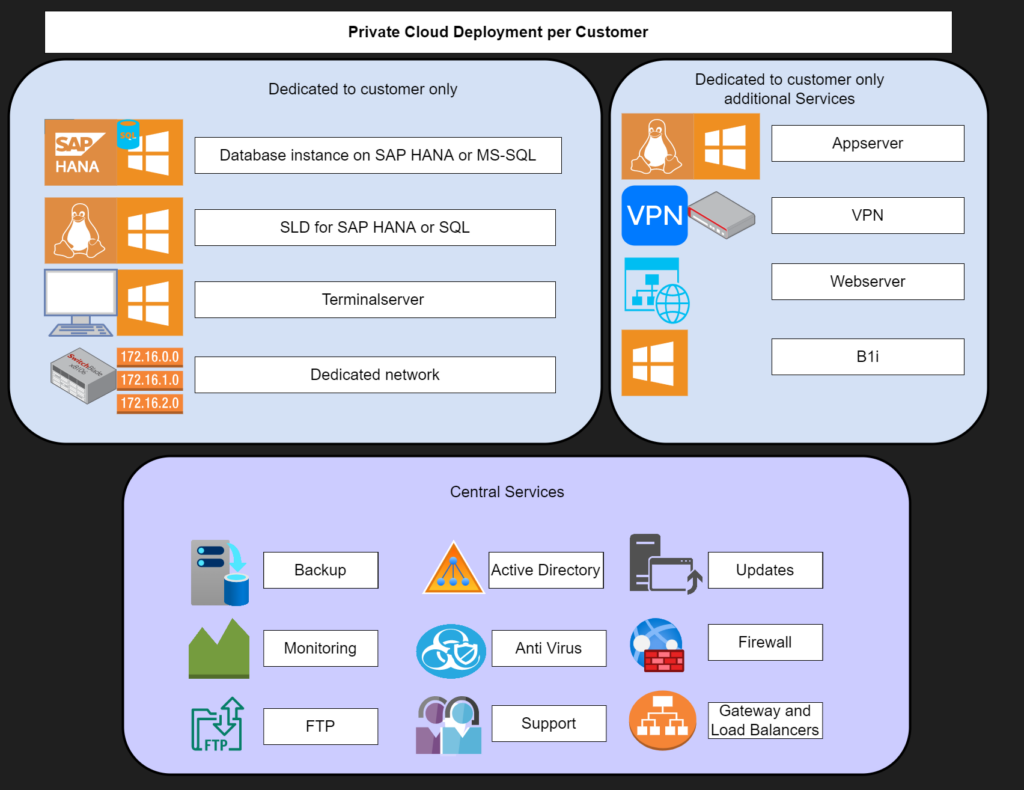The SAP SMB Innovation Summits 2022 are over and we have met a lot of long-term partners. During the chat and exchange of experiences, one thing was highlighted several times: the switch to Private Cloud!
We are proud of the feedback we have received that the customer experience increased over the past few years by switching the deployment of Private Business One Cloud systems as default for every customer. The partners and customers are more satisfied with the services they get and are very happy with the new systems.
Behind this there was a lot of work for our technical team. Here you can get an overview of some of the technical challenges we have overcome:
- The decision was made in 2019 to switch our customers from Cloud Control Center (CCC) to a Private Cloud system.
- All new customers will get a Private Cloud System.
- We still have CCC systems and in some cases, they are still a good option, for example for larger companies looking for a global rollout, this can be a good solution.
- Also, a number of legacy systems are running in CCC and will be migrated to Private Cloud systems in the future.
First, we had to redesign the layout of our customers' system.
In the CCC, all customers use it as a centralized landscape that manages databases, files, permissions, licenses etc.
In the Private Cloud we need to manage all these kinds of services individually in smaller parts.
Automation was an important issue in this case, as we started to automate almost the entire deployment of the SAP B1 installation. This was a hard work of development and testing. With PowerShell, ansible and phyton we are now able to create an SAP Business One landscape with database backend, terminal server, RDP and web access with a few clicks.
Since all members of the support team need to manage this, we have embedded it into user-friendly web interfaces so that everyone can take care of the deployments. All deployments are the same, until the customer specific configuration begins.
Many customers use web servers for web shops, individual applications, self-developed add-ons and extensions. In these cases, the CCC is not able to provide the compatibility and flexibility for such integrations.
Switching to Private Cloud with Openstack as infrastructure platform was key to achieve this goal with the usage of the powerful tools developed and maintained by the Openstack community, where SAP is also a project contributor.

Beside the system design we also think about auditing and monitoring.
It is very easy in CCC to deploy all customers, as well as their databases and resources.
In the Private Cloud, these are individual and there is no centralized tool for auditing.
So, we develop our own tools that count resources and users and report these to the controlling department.
The support team works also with this data as they need to retrieve the customer resources to grant support, do maintenance or customizations. The challenge here was that we needed to be able to manage many more systems than before.
Private Cloud means that each customer has at least one terminal server, SLD server and an own database backend whether SQL or HANA.
Additionally, they have an OU in our Active Directory which makes it possible to customize security policies based on customer requirements. Thus, each customer is completely isolated from other customers due to an own network range.
For the monitoring we have developed monitoring plugins that extend our monitoring to track for example the SLD availability. After some developments, we are now able to check if it is possible to log on to the SLD from the centralized monitoring.
In summary, it was a huge amount of work from all parts in Cloudiax to make this change as successful as it is.
In the context of the Cloud, people often talk about CI/CD (Continuous Integration/Continuous Delivery), we always work on improvements.
Whether it was the hypervisor from VMware (HANA) and HyperV over to Openstack based on KVM or software such as load balancers/RDS solutions, we are not afraid to make changes, no matter how much effort it takes, if in the end it improves the customer experience.



